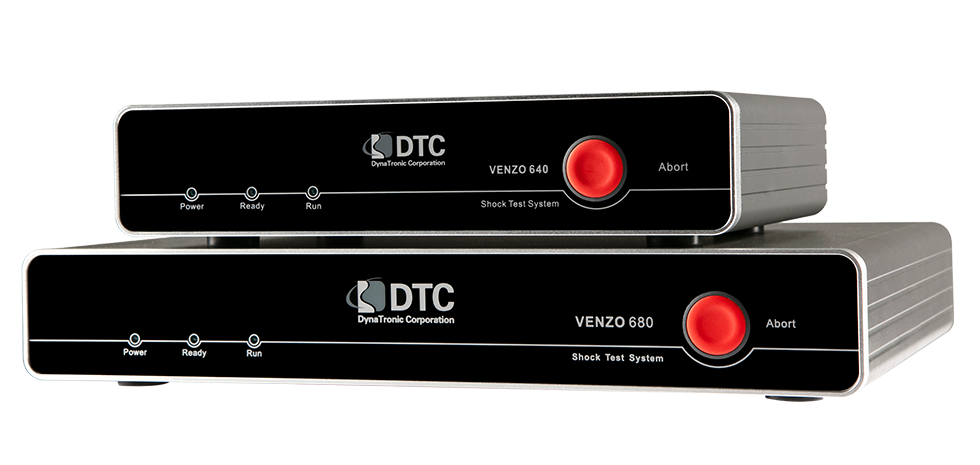4 Input channels
DTC has successfully attended the Automotive Testing Expo China 2023 2023-08-20
Vibro-Shock Test 2022-09-21
How to connect multi-vibration controller? 1970-01-01
VENZO 640 shock test system is the tailored instrument for drop tester, shock tester and bump testing machine. It allows the test engineer to acquire any transient event such as drop test, crash test or shock pulses. When the external input match the defined trigger conditions- trigger level, slope and position, VENZO 640 will trigger to capture the transient event and display the pulse graphics, and additional SRS analysis gives the instant estimation of the potential damage. A series of pulses can be captured and in the mean while throughput to disc in a continuous data stream for post-analysis. VENZO 640 can also control the shock machines’ movements as specific requirements of customers.






Collect and analyze the test data of shock systems (such as shock machine, bump machine, etc.) that can generate waveforms such as half sine, final peak saw tooth and trapezoidal.
Trigger
Trigger Channel: Any active channel, specified channel or none
Trigger Slope: Rising, Falling and Bi-slope
Trigger Level: Specified level, Percentage of target pulse peak or Specified acceleration level
Pre-trigger: Advance trigger, 0-100%
Ideal Waveform
Waveform: Half-sine, Final peak saw tooth, Trapezoid
Standard: MIL-STD-810G, MIL-STD-202-213, IEC 68-2-27, User defined
SRS Analysis
SRS type: Primary, Residual, and Composite
Resolution: 1-1/48 octave analysis
Reference Frequency: User-defined
Damping Ratio: 0.1%-100%
Used to collect and analyze the test data of the shock systems (such as shock response spectrum testing machine) that can generate the corresponding pulse signal.
Reference Spectrum
Setting: Set Frequency, Left / Right Slope, Acceleration Amplitude, Tolerance and other parameters, can calculate break points
Fractional Octave Number (1/N): 1~48
Reference Frequency: User-defined
Trigger
Trigger Channel: Any active channel, specified channel or none
Trigger Slope: Rising, Falling and Bi-slope
Trigger Level: Specified acceleration level
Pre-trigger: Advance trigger, 0-100%
Sampling
Capture Duration: From 1 to 10,000 ms
Sampling Frequency: 320 Hz to 204.8 kHz
Used to collect and analyze random pulse waveforms, such as explosion shock, etc.
Trigger
Trigger Channel: Any active channel, specified channel or none
Trigger Slope: Rising, Falling and Bi-slope
Trigger Level: Specified level, Percentage of pulse peak, Specified acceleration level
Pre-trigger: Advance trigger, 0-100%
Sampling
Capture Duration: From 1 to 10,000 ms
Sampling Frequency: 320 Hz to 204.8 kHz
SRS
SRS Type: Primary, Residual and Composite
Fractional Octave Number (1/N): 1~48
Reference Frequency: User-defined
Damping Ratio: 0.1%~100%
Can collect continuous vibration signals to meet general vibration test requirements.
Sampling Parameters
Sampling Frequency: 80 Hz to 51.2 kHz
Frequency Range: 25 Hz to 20.48 kHz
Sampling Numbers: 128 ~ 65,536 points
Frame Time: Automatic calculation
Automatic calculation
Trigger Channel: Any active channel, specified channel or none
Run Mode: Auto trigger, Manual Trigger
Level: Specified voltage level
Slope: Rising, Falling, Bi-Slope
Delay: Advance or lag trigger, -100%~0%~100%
Damping Ratio: 0.1%~100%
4 Input channels
Up to 204.8kHz sampling rate
24-bit Inputs
1 years Hardware Warranty
<-100 dB THD
DSP Processor
Demo Unit with ALL software

8 Input channels
Up to 204.8kHz sampling rate
24-bit Inputs
1 years Hardware Warranty
<-100 dB THD
DSP Processor
Demo Unit with ALL software

DTC has successfully attended the Automotive Testing Expo China 2023 2023-08-20
Vibro-Shock Test 2022-09-21
How to connect multi-vibration controller? 1970-01-01
By continuing to use the site you agree to our privacy policy.